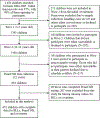Childhood lead exposure and sex-based neurobehavioral functioning in adolescence
- PMID: 35988749
- PMCID: PMC10433489
- DOI: 10.1016/j.neuro.2022.08.008
Childhood lead exposure and sex-based neurobehavioral functioning in adolescence
Abstract
It is well documented that childhood lead exposure is associated with long-term decreases in intelligence quotients (IQ). Lesser known is the relationship with neurobehavioral domains, especially in adolescence. This study sought to identify cross-sectional and longitudinal associations between lead exposure and adolescent executive and visual-motor functioning and examine sex-based differences. Participants were 681 children from Jintan, China who had their blood lead levels (BLLs) assessed at age 3-5 years and 12 years old and neurobehavioral functioning assessed through the University of Pennsylvania Computerized Neurocognitive Battery (PennCNB) platform http://www.med.upenn.edu/bbl at 12 years old. Mean BLLs were 6.41 mcg/dl at age 3-5 years and 3.10 mcg/dl at 12. BLLs at 3-5 years and 12 years were used as predictors for the individual neurobehavioral domains in general linear models while controlling for father and mother occupation and education, residence location, age, and adolescent IQ. Models were run separately for males and females. In adjusted models, males BLLs at 3-5 years were associated with increased time to correctly complete tasks in multiple domains including abstraction/flexibility (β = 19.90, 95% CI( 4.26, 35.54) and spatial processing (β = 96.00, 95% CI 6.18, 185.82) at 12 years. For females in adjusted models, BLLs at 3-5 years were associated with increasing time to correctly complete tasks on the episodic memory domain task (β = 34.59, 95% CI 5.33, 63.84) at 12 years. Two adolescent cross-sectional relationships remained in the adjusted models for males only, suggesting a positive association between BLLs and increasing time for correct responses on the attentional domain task (β = 15.08, 95% CI 0.65, 29.51) and decreasing time for correct responses on the episodic memory task (β = -73.49, 95% CI -138.91, -8.06) in males at 12 years. These associations remained with and without controlling for IQ. These results suggest that lead exposure is associated with overall deficits in male and female neurobehavioral functioning, though in different domains and different timing of exposure.
Keywords: Child development; Executive functioning; Lead exposure; Neurobehavioral functioning.
Copyright © 2022 Elsevier B.V. All rights reserved.
Conflict of interest statement
Declaration of Competing Interest The authors declare that they have no known competing financial interests or personal relationships that could have appeared to influence the work reported in this paper. Competing interests The authors have no competing interests to declare.
Figures
Similar articles
-
Childhood lead exposure and sleep problems in adolescents: a longitudinal cohort study.Int Arch Occup Environ Health. 2024 Nov;97(9):959-970. doi: 10.1007/s00420-024-02099-3. Epub 2024 Sep 14. Int Arch Occup Environ Health. 2024. PMID: 39277560 Free PMC article.
-
Low level lead exposure in early childhood and parental education on adolescent IQ and working memory: a cohort study.J Expo Sci Environ Epidemiol. 2023 Mar;33(2):168-176. doi: 10.1038/s41370-022-00450-9. Epub 2022 Jun 24. J Expo Sci Environ Epidemiol. 2023. PMID: 35750750 Free PMC article.
-
[Intelligence and neurocognitive tests among students living in a industrialized region of Sardinia with relatively low blood levels of lead].G Ital Med Lav Ergon. 2013 Jan-Mar;35(1):32-5. G Ital Med Lav Ergon. 2013. PMID: 23798232 Italian.
-
What are the blood lead levels of children living in Latin America and the Caribbean?Environ Int. 2017 Apr;101:46-58. doi: 10.1016/j.envint.2016.12.022. Epub 2017 Feb 1. Environ Int. 2017. PMID: 28159393 Review.
-
Blood lead levels in children, China.Environ Res. 2006 Jul;101(3):412-8. doi: 10.1016/j.envres.2005.11.007. Epub 2006 Jan 25. Environ Res. 2006. PMID: 16442092 Review.
Cited by
-
Prenatal and childhood lead exposure is prospectively associated with biological markers of aging in adolescence.Sci Total Environ. 2024 Feb 25;913:169757. doi: 10.1016/j.scitotenv.2023.169757. Epub 2024 Jan 2. Sci Total Environ. 2024. PMID: 38176546 Free PMC article.
-
Current Understanding of Sex Differences in Metal-Induced Diseases.Curr Environ Health Rep. 2025 Apr 9;12(1):18. doi: 10.1007/s40572-025-00482-x. Curr Environ Health Rep. 2025. PMID: 40202678 Review.
-
Effects of Blood Lead Levels <10 µg/dL in School-Age Children and Adolescents: A Scoping Review.Pediatrics. 2024 Oct 1;154(Suppl 2):e2024067808F. doi: 10.1542/peds.2024-067808F. Pediatrics. 2024. PMID: 39352036
-
A framework for evaluating less-than-lifetime exposures: advancing toxicological risk assessment for drinking water quality.Arch Toxicol. 2025 Aug;99(8):3147-3168. doi: 10.1007/s00204-025-04061-9. Epub 2025 May 25. Arch Toxicol. 2025. PMID: 40415114 Free PMC article. Review.
-
Childhood lead exposure and sleep problems in adolescents: a longitudinal cohort study.Int Arch Occup Environ Health. 2024 Nov;97(9):959-970. doi: 10.1007/s00420-024-02099-3. Epub 2024 Sep 14. Int Arch Occup Environ Health. 2024. PMID: 39277560 Free PMC article.
References
-
- Ardila A, Pineda D, Rosselli M, 2000. Correlation between intelligence test scores and executive function measures. Arch. Clin. Neuropsychol. 15 (1), 31–36. - PubMed
Publication types
MeSH terms
Substances
Grants and funding
LinkOut - more resources
Full Text Sources
Medical


